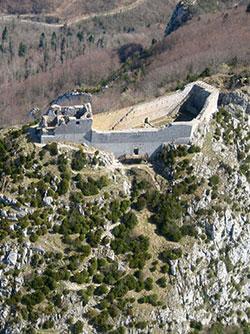Signal Hill
Towards the end of the 19th century, physicists considered radio waves to be “invisible light.” In many respects, that is exactly what radio waves are: an electromagnetic frequency, oscillation or signal outside of the visible spectrum that allows communication to occur over great distances. One of the wonders of creation is that communication of this nature is only possible due to the ionosphere—a layer of our atmosphere—above us. The waves emitted from an electromagnetic impulse are sent at the speed of light outwards and upwards, and without the ionosphere reflecting these signals back to earth, many waves would fly away into space.
The practical use of these waves as a method of communication is largely attributed to one man: Guglielmo Marconi. From an early age, Marconi became fascinated with electricity and, specifically, with the production and detection of electromagnetic radiation, now commonly known as radio waves. Up until this time, the quickest form of communication was the telegraph system, which required cables spanning great distances in order to send an electronic current between a transmitter and receiver. What Marconi developed was a wireless method of transmitting an electrical impulse through the air and then receiving this signal at another location. Early models of wireless receivers used a glass tube containing iron shavings to detect the electrical impulse. These shavings, which were connected to an open circuit and an alarm bell, would become electrically charged and stick together when the electromagnetic impulse was detected. The electrical surge would form a circuit and then the bell would ring.
Caught by a Kite in Canada!
What can seem, on the surface, to be nothing more than a primitive manipulation of an electronic current actually became a remarkable method of communication that has powerfully shaped our society. On December 12, 1901, Marconi was in Newfoundland—a British Dominion in present-day Canada. There, he received the first transatlantic wireless transmission sent from Cornwall in the United Kingdom to the appropriately named Signal Hill. Poised with his instruments, Marconi waited for the signal to be sent, while a kite flew 500 feet above his head, flapping in the wind and holding his receiving antenna aloft. From the transmitter in Cornwall to the antenna kite in Signal Hill, there is a distance of approximately 2,200 miles (3,500 kilometers). The success of transmitting a signal over this distance with the basic instruments available to them is such an impressive feat that, to this day, many skeptics still question the veracity of Marconi’s claim. Yet it is undoubtedly because of these experiments and Marconi’s dedication to his work that the benefits of radio waves were realised. Ships at sea were now able to communicate with one another and emit distress signals. For example, it is commonly understood that the only reason there were any survivors from the sinking of the Titanic, only a little more than 10 years after the experiment in Newfoundland, was because Marconi radio operators on board the vessel were able to send out a distress signal, which was received by the RMS Carpathia.
The British Navy was quick to apply this form of direct communication, sending Morse Code to vessels at sea. Shortly thereafter, harnessing radio waves—especially once transmitters were fine-tuned to oscillate at a particular frequency—led to widespread adoption of radio communication. With the further development of “amplitude modulation,” or AM radio, for the first time in human history a voice could be heard over the airwaves and the power to reach a worldwide audience had been achieved.
“Pirate Radio” and the Radio Church of God
The BBC (the British Broadcasting Company, later to become the British Broadcasting Corporation) began transmitting public radio in 1922 as a service to inform, educate and entertain. Due to concerns about potential disruption of military and civil communications, heavy regulatory restrictions were placed on who, when and what could be broadcast. By the early 1930’s, Radio Luxembourg was established and adopted, largely by English-speaking broadcasters, as a method of circumventing the monopoly held by the BBC. This was the birth of “pirate radio” and would, for the majority of the twentieth century, be used as a method of broadcasting content to Europe and the British Isles that would otherwise not be heard.
In 1934, a program by the Radio Church of God, later known as “The World Tomorrow,” began to broadcast out of Eugene, Oregon by Herbert W. Armstrong. The program transmitted the same message of the coming Kingdom of God that you read in this magazine today, and which you can watch on the Tomorrow’s World program, aired around the world on television and online. After spreading to various radio stations across North America, the program began to be aired on Radio Luxembourg in the 1950’s, and Mr. Armstrong’s efforts grew into a truly worldwide work.
The birth of mass communication brought with it the first opportunity to preach the good news of God’s coming Kingdom to a truly global audience. No longer would it always be necessary to travel in person in order to speak to audiences scattered all about the planet.
Information Everywhere
The effectiveness of radio waves as a method of communication has since increased to include television and more recently the Internet. The ease with which information can now be transmitted and shared abroad has resulted in a veritable “information explosion”!
Everyone is now able to inform, educate and entertain on a global stage—but there is an obvious risk associated with this technology. Paul refers to our adversary, Satan the devil, as “the prince of the power of the air” (Ephesians 2:2), and—in much the same way that electronic signals can be sent out to deliver a message of hope—the ideas and influence of corrupt and debased minds can also be transmitted into our very homes. And the volume of media we consume and share today on social media platforms such as Twitter, YouTube and Facebook—much of it distasteful or vulgar—poses one of the greatest challenges facing society. Marconi’s marvelous discovery may have accelerated humanity’s technical progress, but it did not change human nature.
As the radio waves bounce and reverberate around us, this form of “invisible light” must be used for good—as both an example and a witness for the troubled world today. However, it is not just the content of messages delivered by groups or governments that matters. What matters is our own, individual approach to communication, and whether or not we set the right example each time a post, picture or video is uploaded. Ever since the first transatlantic transmission was received on Signal Hill, opportunities to individually and collectively demonstrate and educate the world about God’s ways have increased at a phenomenal rate. May we use them to be “the light of the world. A city that is set on a hill” (Matthew 5:14).






